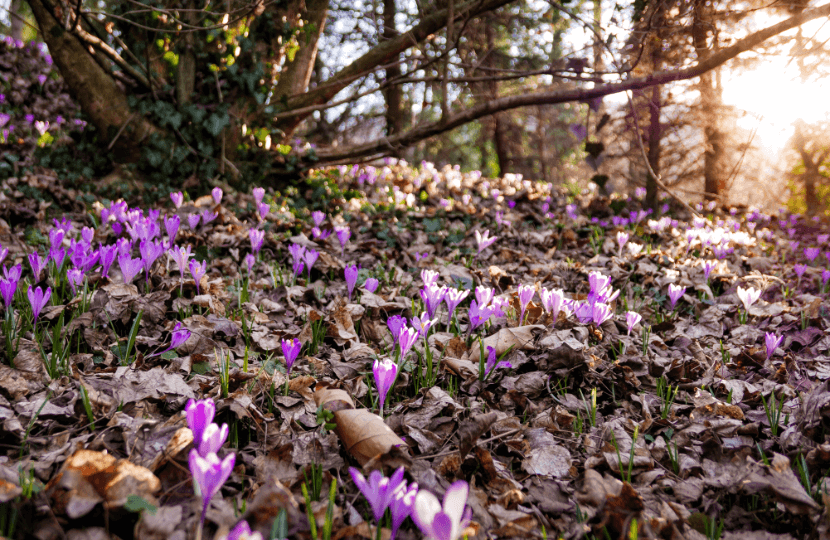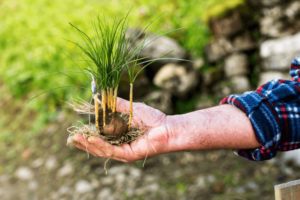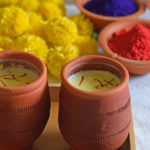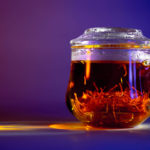Saffron Nutrients
Saffron contains more than 150 volatile compounds, including carotenoids, safranal, crocin, antioxidants, and other biochemicals. Along with that also contain important minerals and vitamins that are essential to human health. As per USDA, saffron contains, Vitamins A, vitamin C, riboflavin, niacin, and thiamin. Apart from that, it also contains vitamin B-6, folate, vitamin B-12, potassium, iron, magnesium, phosphorus, sodium, and zinc.
Botanical name Crocus sativus ▪ Family name Iridaceae
Saffron consists of the dried stigmas of the saffron crocus, or roses as they are called. The saffron plant is a bulbous, autumn-flowering, perennial of the iris family.
Native range Mediterranean Region, Western Asia
Major producers Spain, Iran, China, Kashmir Region of India.
Harvesting The saffron flowers are carefully harvested by hand at dawn and the three red stigmas plucked from each one. These are toasted, or dried, in sieves over a very low heat to fix the colour. One kilogram of dry saffron needs 500,000 to 1,000,000 stigmas and this, together with the intensive labour required to harvest the crop by hand, accounts for its extremely high price in comparison with other spices.
Taste and aroma The aroma of saffron is rich, pungent, floral, and sometimes with a hint of honey. The aromatic properties vary slightly depending on the saffron’s place of origin. The taste is delicate yet penetrating with warm, earthy, musky tones.
Culinary uses Saffron is added to special dishes in many cuisines, often dishes associated with festivals or celebrations. It provides the characteristic flavour for many Mediterranean fish soups and stews of which Provencal bouillabaisse and Catalan zarzuela are the best known. It also provides the characteristic colour of Spanish paella and Italian risotto Milanese.
Other uses Saffron is used in sedatives, as an antispasmodic, and for flatulence. It is also used in perfumes and dyes (including for the robes of Buddhist monks) and, being so expensive, it is considered to be an aphrodisiac in some cultures.
Historical uses Saffron was used by ancient civilisations as a dye and to flavour food and wine.
Storage If stored in an airtight container in a cool, dark place, saffron threads will keep their flavour for 2–3 years.
Click here for more information on saffron.
Saffron. The name itself sounds decadent, exotic, alluring. Red strands tinged with yellow; a fiery beauty which humans have found irresistible for millennia. Most people know that saffron is rare and expensive, but many have never had the chance to experience its subtle, sophisticated charms for themselves. For those people, we hope a little history and description of this most prized of all spices will help convince you to take the plunge.
What Is Saffron
Saffron is harvested from Crocus sativus, a flower is better known as the “saffron crocus.” Each bloom from this crocus produces three yellow styles, each of which ends with a crimson-red stigma. The combination of golden style and crimson stigma constitute what we know as a saffron thread. These threads are plucked by hand and dried, resulting in a fragrant, beautiful spice that is prized the world over.
Why Is Saffron So Expensive
Now that you know where saffron comes from, you may still find yourself wondering exactly why it is so costly. The answer, in short, is that it is extremely tricky to harvest. The saffron crocus only blossoms during a short period in the fall. Once a flower blooms, it must be harvested that same day, as it begins to wilt almost immediately. Since each flower contains only three delicate stigmas, it takes upwards of 50,000 flowers to yield one pound of dried saffron. Considering the intensive work needed for a comparatively small yield, it is not difficult to see why Saffron is so expensive.
How To Use Saffron
We know what you’re thinking. It’s great to know why saffron is so rare and expensive, but what do I do with it? What does saffron taste like? That question is not quite as easy to answer. Appropriately, given the air of mystery surrounding the spice, saffron seems to have different characteristics to different people. Some will note its sweet, honey-like flavour, while others find it earthy and musky. Yet others are able to detect a balance of the two. Saffron is prized as much for its colour as its flavour, imparting a rich, golden hue onto recipes ranging from saffron risotto, to a variety of curries, to classic French bouillabaisse. It can even be used in desserts, such as pudding, cakes, and sweetened rice. If you are worried about the expense, don’t fret! A little goes a long way. For most dishes, you will only need 1-3 saffron threads to get the desired effect.
Types Of Saffron
Just as saffron is prized in many parts of the world, it is actually harvested in a few different places as well. While the general characteristics of saffron will not vary much, there are some distinct qualities to each variety, and connoisseurs tend to have their own preferences.
To help you get started on the path to finding your own favourite, let’s take a look at the three types of saffron we proudly offer.
- Iranian SaffronIn Iran, saffron is cultivated by professional growers, who don’t use chemical materials for cultivation. Sargol saffron has no synthetic pesticides, preservatives, food additives or colorings. Our Iranian saffron is Sargol grade. Sargol literally means “top of the flower,” which denotes the fact that it doesn’t contain any of the yellow style. It is made up entirely of the red stigma of the flower, which is where saffron gets most of its flavor and aroma. The result is the highest quality saffron available to the public.
- Greek SaffronSaffron from Greece is irreplaceable: musky, sweet, floral, bitter, and bolder than other saffron. The flavor is strikingly earthy, with notes of honey and violet. Greek saffron is generally earthier and a touch more bitter than other types of saffron, but the honey notes are much more intense.
- Spanish SaffronCalled Azafran by the Spanish, this variety of saffron spice is mellow, sweet, and floral. The aroma is irreplaceable: musky, honeyed, floral, bitter, and fierce. You’ll find the perfume to be hypnotic. The flavor is penetratingly husky, earthy, with notes of honey and violet.
- New Zealand Saffron
SAFFRON
This beautiful herb has been shown to help in a multitude of ways:
- Balancing effect on neurotransmitters and assisting cheerful mood
- Supporting mental clarity and cognition
- Soothing and calming smooth muscle function, assisting a healthy comfortable menstrual cycle and easing irritability
People across the globe have valued Saffron as both a spice, herbal remedy, and for its vibrant yellow colour for over 4000 years. The spice, derived from the 3 red stigmas of each flower, is still one of the world’s most costly substances. It takes about 36,000 flowers to yield just over 2 kilograms of stigmas! Saffron’s use in traditional herbal medicine can be traced back to many countries including Greece, China and the Middle East where it was originally cultivated.
A recent meta-analysis has shown the positive support that saffron can have on a healthy and happy moods, making it a great choice for those who need a bit of a lift in this area.
Research has also shown that saffron assists discomfort during the menstrual cycle if taken for 2 – 3 months. Supporting normal inflammatory responses and healthy smooth muscle tissue seems to be a key area of function for Saffron. Because Saffron is also wonderful support for a healthy mood, it can assist with feelings of worry and irritability during the cycle as well.
Clinical research has shown that saffron can support the health of nerve tissue in the eyes, mainly because of its action as an antioxidant. It is a useful nutrient to support vision and healthy ageing of the macular.
In older people, when brain support is needed, saffron helps nourish the nerves and assist healthy brain function and cognition.
So apart from looking pretty in the garden or providing a vivid colour to a dish, saffron can help our wellbeing in many ways. For clinical nutrition, saffron is available in capsules as saffron extract in researched recommended dosages.
Saffron has been cultivated for its valuable stigma for over 3000 years. Each flower has three red stigma (or threads) which droop out from the centre of the flower. These have been used since ancient times in cosmetics, perfumery, cooking and traditional remedies.
Growing saffron is a delicate balancing act. It requires cold winters, hot summers, low humidity, just the right amount of rainfall (or irrigation) and the right type of friable free-draining soil. The areas in New Zealand ticking all these boxes are probably only Central Otago, Marlborough and Nelson. However, with a harvest so valuable it could be worth planting out a few rows in areas that potentially have a suitable microclimate.
Saffron is grown from a corm (or bulb) which should be planted in its dormant period over summer. Prepare the soil by working in fertiliser (such as blood and bone) and working it up into raised beds. Soil type needs to be loose and friable with a high nutrient content to allow effortless root penetration.
Plant the corms 10cm deep and 10 – 15cm apart in the raised beds. Purchase good quality large corms, they will produce dozens of daughter corms over following years. The more corms you have the more flowers you’ll produce. Each corm produces between 6 and 12 flowers in a season and the original size of your corm dictates the size of its daughters and the quantity of flowers it produces.
Saffron flowers in its first season of planting. Flowering starts in the first week of April and lasts around 5 – 6 weeks. The majority of flowers will arrive in an intensive 3 week period starting in the middle of April. Each flower must be picked within 48 hours of appearing. Ideally picking is done early in the day after the dew dries and before the sun begins to wilt the flowers.
It takes around 150,000 flowers (or 450,000 threads) to produce a kilogram of dried saffron, depending on the quality of the flowers. This number of flowers needed could be as high as 200,000 flowers for smaller, poorer quality flowers.
The yield you can expect per hectare is dependent how long the corms have been in ground producing daughters and on the growing and environmental conditions. If you have had the corms in for around 4 years and all the conditions are ideal, you might get as high as 24 kilos of saffron per hectare. If conditions aren’t ideal you could get as little as 2.5 kilos (or none if conditions are completely unsuitable).
Once the flower is picked it is vital they are dried as quickly as possible to retain quality threads. Drying can be done with a dehydrator, hot air flow or freeze drying. All methods have their benefits but the most important thing is to dry as quickly as possible and not to over dry. 10% moisture will ensure quality long-term storage and a product which retains its colour, flavour and aroma.
Saffron needs fertilising once or twice a year and the beds should be kept weed free. Mulching the beds with sawdust helps with weed control. Every few years the corms need to be lifted – they become overcrowded and affect the crop yield as they compete for diminishing space. They also tend to grow on top of one another diminishing the space between the soil and the surface. Keeping the crop watered is important for producing quality flowers. However, take care not to over water – it will deter flowering and increase humidity causing fungal disease. Watering the crop just before flowering helps to produce larger flowers – yielding larger (heavier) threads.
Care needs to be taken to protect the corms from predators such as rabbits and rats. They can dig up and eat the precious bulbs during the plants dormant season.
Harvesting saffron is very, very labour intensive and it is this that contributes to saffron being the world’s most expensive spice.
Saffron is one of Iran’s non-oil exports. Although it’s grown in only a few provinces throughout the country, it’s easy to find it in the various spice markets. Persian Saffron; the Red-Gold ingredient grows from late October to mid-November, early in the morning before the sunlight women harvest the flowers before they bloom, so the stigma (which is the actual Saffron) is out of any dust. Once the flowers picked, they start the process of separating the purple stigma from the purple crocus flower.
Later, the drying process starts by sun-dried, or by the machine to ensure no dust come into contact with Saffron. The process, however, is completely dependent on the weather. If the weather become cold earlier that year they have to start the harvest as soon as possible.
In this article we are going to give you more information about this red-gold ingredient and different types of it. So you have enough information when you want to buy some at any local market.
Saffron’s taste results from two chemicals called picrocrocin and safranal. The golden-yellow color is because of carotenoid pigment.
Types of Persian Saffron
Iran is known for the best quality Saffron in the world. However, you should always remember that there are different kinds of Saffron with four main types, each with different quality. These four types are Sargol, Super Negin, Negin, and Poshal.
1. Sargol: In Farsi it literally means “Top of the flower” which derives from the very tip of the saffron thread. It has a specific, powerful aroma more than other types. It is also known as high quality since it does not contain any Yellow or Orange threads. However, during the harvest, and separation process, Sargol saffron often contains crumbs and broken threads.
2. Super Negin: This type is the most expensive but rare trim of Saffron. It is known not only for the most potent but also for its aesthetically pleasing features. Super Negin threads are longer and contain no yellow or orange threads. The threads are cut symmetrically and contain no crumbs. When comparing all the trims of Saffron, Super Negin is the best considering the quality, color, and taste.
3. Negin: This type of Saffron is longer in length but contains some yellow and orange portions. However, the aroma, quality, and purity are still great but the color is not perfect due to some portions of yellow and orange threads, which makes this type less quality than others.
4. Poshal: The cheapest and least quality type of Saffron is known as Poshal. This Saffron is from yellow parts of the stigma which contains no value, taste, and aroma.
To conclude, as long as Persian Saffron known as one of the best quality products, it should always be bought from a reputable and trusted source.
Read more: The most delicious food in Iran
Usage of Saffron
Saffron is widely used in Iran, India, European Countries, and Arab cuisines due to its great taste, and colour. It is also used in confectioneries and drinks.
Saffron has a long history of use in traditional medicine. It is known as a remedy for asthma, cough, whooping cough, and to loosen phlegm. It is also used for sleep problems (insomnia), depression, Alzheimer’s disease, fright, shock, spitting up blood (hemoptysis), pain, heartburn, and dry skin.
Saffron has also been used as a fabric dye, particularly in China and India. In India, it is also used for religious purposes.
In comparison to other spices or dried foods, the nutrient content of dried saffron shows the richness of nutritional value across B vitamins and manganese.







